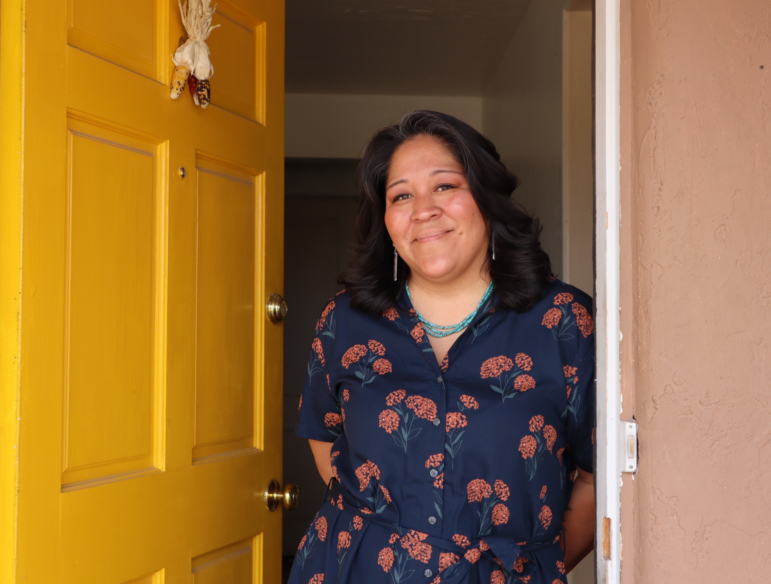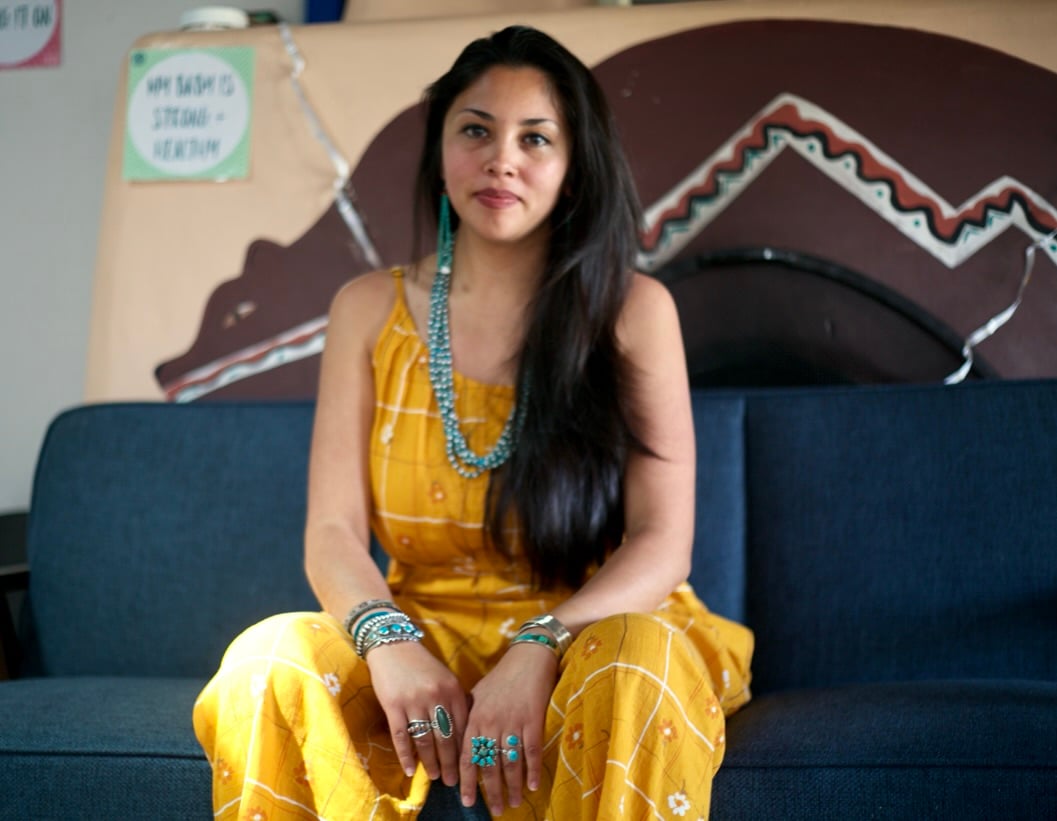Aspen Mirabal has traveled across Northern New Mexico working with women during pregnancy, birth and postpartum. A member of Taos Pueblo, her work as a doula focuses on ensuring Indigenous women deliver safely in and out of hospitals.
“Sometimes clients don’t know how to advocate for themselves if this is new for them,” said Mirabal about the language spoken among providers in hospitals. Doulas can help with that.
Nicolle Gonzales saw a similar need as Mirabal and decided to pursue midwifery.
“I was very unhappy seeing how the community was being taken care of in hospitals,” Gonzales said. “That really pushed me to go back to school and become a nurse midwife.” Gonzales later formed a nonprofit health organization called Changing Woman Initiative with a focus on reclaiming Indigenous cultural birthing practices.
Today, an effort is growing to make it easier for Indigenous people to access doulas and midwives from their own communities, like Mirabal and Gonzales.
Prior to the establishment of the Indian Health Service (IHS), the federal medical system that serves Native populations, most Indigenous births happened outside hospitals with the assistance of women. With the inception of the IHS in the 1950s, those traditions continue but have diminished, with most births now at hospitals.
Doulas and midwives, long an integral part of Indigenous birthing traditions even if they were called by a different name, help women stay healthy during and after pregnancy, whether births take place in hospitals or at home. Doulas provide a range of support to women. For instance, they might educate them on how to support their babies and have healthy diets, assist with pain management and offer emotional support. Certified midwives can provide prenatal medical care, and certified nurse midwives can perform the same procedures as some obstetrics physicians in hospitals.
Both professions have been shown to improve birthing outcomes in Indigenous communities, where women are more likely to die during pregnancy or birth, or within one year of birth, than women of other groups.
But breaking into the field is strewn with obstacles. The cost of training, often including the need to move away from home, can be a challenge. It’s hard for many midwives to sustain a business on the reimbursements they receive from Medicaid, the government insurance program that pays for more than 70% of births in New Mexico. Lawmakers this year included $5.8 million in the $10 billion state budget for birthing doulas and lactation counselor services, wrote Tim Fowler, spokesperson for the New Mexico Human Services Department, in an email, and federal matching funds will raise the total available to about $21 million. But how much individual doulas will receive per patient remains unclear.
High costs and culturally deficient training programs
Gonzales attended nursing school at the University of New Mexico, worked as a nurse in hospitals, and then completed a masters degree to become a nurse midwife.
Nurse midwives receive higher Medicaid reimbursement rates than other types of midwives, enough to sustain a career. However, years of additional finances and training to reach that certification level are barriers. Administrators at nursing schools find that many Indigenous students don’t pursue additional training after getting their bachelor’s degree, particularly due to the financial burden.
“Students usually stay and find work around the area. There are few that continue their training and education especially in areas like birthing or midwifery. There are even fewer native students that pursue this,” said Jonathan Lumibao, the nursing director at University of New Mexico Gallup (UNM) campus, where Native students make up more than half of the nursing program.
People can opt to achieve less intensive levels of midwifery credentials – certified professional midwives (CPM) or licensed midwives – but the training for those licenses is expensive, too.
“Training is not super well funded. Most people have to pay for their own education,” said Gonzales.

Research shows that mentorship plays a primary role in the success of Native students navigating their career. Monica Larrea, an Indigenous midwife and coordinator at Changing Women Initiative, spends her weekends mentoring young Native students pursuing their midwifery certifications. A lack of Native mentors hinders students’ success, she said.
“It’s upsetting to see. A lot of the midwives we have are not representative of the communities in which these students are coming from, making mentorship tough to get,” said Larrea.
Gonzales was the only Native student in her masters program, she remembers. “It was extremely challenging to navigate the program by myself as the only Native person, and really wanting the support of a mentor,” she said.
And the curriculum “was not designed to be culturally sensitive for Natives,” she said. Nor did the training address the long history of midwifery in Indigenous communities, or how to work with people who don’t regularly access hospitals.
Prospective doulas face similar challenges. There aren’t many culturally sensitive training programs out there.
Mirabal was inspired to become a doula after observing Indigenous midwives in rural Guatemala. When she returned to New Mexico, she enrolled in a training program, but the curriculum did not touch on working with Indigenous people. “It did not feel right,” she said.
Unlike midwifery, which has a more standardized path for training, the length, quality and cost of doula training depends on which organization runs it. In New Mexico, there are only a handful of organizations that center training around Indigenous communities. One is Tewa Women United’s Yiya Vi Kagingdi doula training, based in Española. Mirabal leads its doula program, and said in an email that the training “caters to Indigenous, Black, Brown, and Queer people in New Mexico only.”
To become certified as a full-spectrum doula through the TEWA Women United program, one must complete a seven-month curriculum, then practice for a year or more. The program provides new doulas with mentors and their training is free. In exchange for participating in the program, doulas don’t charge their first few clients.
Sustaining a business can be challenging
Getting trained is one challenge – sustaining a career is another.
Midwives who serve Indigenous populations often rely on Medicaid reimbursements to sustain their practice. However, those reimbursements fall short for some midwives.
“Nurse midwives make pretty good income, anywhere from 70k to 135k, depending on where you are. Whereas CPM alums, if they have their own practice, could maybe make 30k or 35k a year. It’s not super financially supported,” said Gonzales about certified professional midwives who don’t pursue the advanced degrees of nurse midwives.
But not every situation calls for the more technical skillset of the nurse midwife. Sometimes, women want more traditional births that a CPM can provide.
“Not everyone wants to have a nurse midwife because midwifery, especially nurse midwifery, is very medical,” Gonzales said. “It’s important for Medicaid to reimburse midwives accordingly so we can serve communities according to their preferences. Paying midwives properly will help make these careers attractive.”
The Changing Woman Initiative relies mostly on grant funding to cover costs, while using Medicaid to cover a small portion of services, such as lab tests and ultrasounds.
Before joining the Changing Woman Initiative a few years ago, Larrea ran her own practice in Ribera, New Mexico, providing prenatal and birth care to pregnant women.
Medicaid didn’t cover enough of her expenses, she said. She often worked with others to care for patients, which drove up expenses. She said she was lucky if she received $1,500 in reimbursements from the state, for the prenatal and birthing care she provided for one client.
“Often we’re either paying a skilled assistant or are in practice with another midwife that we’re paying.” said Larrea, who eventually shuttered her practice.
“It’s hard because you want to be there for people, but you can’t because it’s hard to sustain your practice,” she said.
Doulas, who historically have never been able to claim Medicaid, will begin receiving reimbursements from the state in July. Until then, doulas are mostly paid out of pocket by clients, as insurance companies in New Mexico don’t cover the service, Mirabal said.
At TEWA Women United, services are free, and the organization pays doulas. However, private doulas charge different rates depending on their clientele.
“A lot of doulas balance having multiple jobs because it’s not easy for families to pay rates out of pocket,” said Mirabal.
